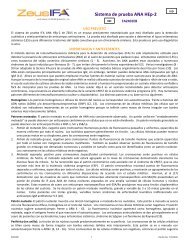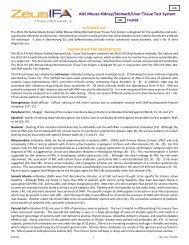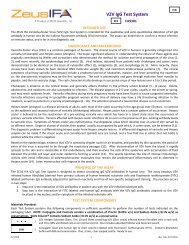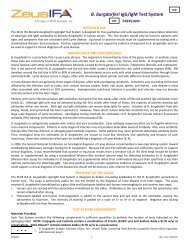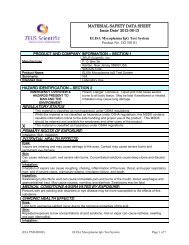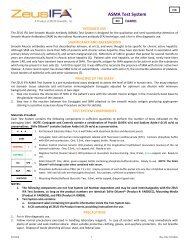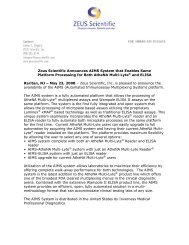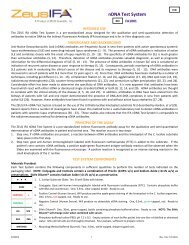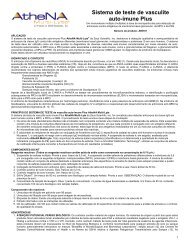FTA-ABS DS Test System - ZEUS Scientific
FTA-ABS DS Test System - ZEUS Scientific
FTA-ABS DS Test System - ZEUS Scientific
Create successful ePaper yourself
Turn your PDF publications into a flip-book with our unique Google optimized e-Paper software.
2. Remove Slides from refrigerated storage and allow them to warm to room temperature (20 - 25°C). Tear open the protectiveenvelope and remove Slides. Do not apply pressure to flat sides of protective envelope.3. Dilute the Reactive and Non-Specific Controls 1:5 in both PBS and Sorbent (e.g.: 50µL of serum + 200µL of Sorbent or PBS).Prepare the 1+ Minimally Reactive Control directly from the heated Reactive Control aliquot. The recommended dilution factoris noted on the Reactive Control vial. Dilution is made in PBS.a. Example:b. 1+ = 1:400 or 1+ = 1 part reactive serum + 399 parts PBS,c. or 100µL sera + 39.9mL PBS = 1:400 dilution.d. This would represent the 1+ Minimally Reactive Control.4. Prepare 1:5 dilutions of all test specimens in Sorbent.a. To appropriately labeled tubes, add 200µL of Sorbent.b. Add 50µL of heat inactivated serum specimen. Mix well.5. Reserve 2 wells on the Control Slide. One for the Sorbent Control, the other for the PBS (Conjugate) Control. A total of sevenControls are required according to CDC recommendations for each day’s testing (see Interpretation Section). All dilutions mustbe thoroughly mixed prior to testing.6. Add 10µL of diluted test and Control sera to each appropriately identified Substrate Slide well. Include 10µL of Sorbent and10µL of PBS in their respective wells.7. Incubate at 35 - 37°C for 30 minutes.8. Rinse Slides briefly with PBS. This is best accomplished by slightly tilting the Slide and flooding the multi-well Slide with a streamof PBS directed between the top and bottom rows of the Slide. Tilt Slide in opposite direction and repeat rinse. The staggeredpositioning of the test wells minimizes possible cross contamination (see Precautions Section).9. Wash Slides for two, 5 minute intervals, changing PBS between washes.10. Rinse Slides for about 5 - 10 seconds in a gentle stream of distilled water as in step 8, and air dry. Slides must be completely drybefore proceeding.11. Place 10µL of anti-human Conjugate (TMRITC) on each well.12. Repeat steps 7 - 10.13. Place 10µL of anti-Treponemal Conjugate (FITC) on each well. Incubate 35 - 37°C for 20 minutes.14. Repeat steps 8 - 10.15. Place a small amount (4 - 5 drops) of Mounting Media between the two rows of offset wells and coverslip.16. Read the Slides as soon as possible. If a delay in reading is necessary, place Slides in a dark room and read within 4 hours.17. Locate and focus treponemes with the fluorescein (FITC) filter system.18. After the treponemes have been located, dial in the rhodamine filter to read specific red fluorescence.19. Using the 1+ Minimally Reactive Control Slide as the reading standard, record the intensity of fluorescence according to thechart entitled, “Reading and Reporting Results,” in the Interpretation of Results section of this Package Insert.NOTE: The type and condition of the microscope used may influence the visual appearance of the image obtained. The 1+reaction may vary due to the type of microscope employed, the light source, age of the bulb, filter assembly, filter thickness, aswell as other parameters. As a result, it may be necessary for laboratories to prepare the 1+ Minimally Reactive Control at adilution other than that recommended by the manufacturer. In such cases it may be advisable to employ the use of secondarystandards.QUALITY CONTROLPrepare Reactive and Non-Specific Controls in both PBS Buffer and Sorbent. Prepare a 1+ Minimally Reactive Control in PBS buffer.PBS Buffer and Sorbent Controls should be run with each assay. It is recommended that the Control Slide be read prior to evaluatingtest results. This will assist in establishing the references required to interpret the test sample.Expected Control Readings:Reactive Control Rhodamine Fluorescence FITC Fluorescence1:5 in PBS R (4+) 1+ to 2+1:5 in Sorbent R (3+ to 4+) 1+ to 2+Minimally Reactive Control, PBS Dilution 1+ 1+ to 2+Non-Specific Control1:5 in PBS R (2+) 1+ to 2+1:5 in Sorbent N 1+ to 2+Control for nonspecific staining by ConjugatePBS N 1+ to 2+Sorbent N 1+ to 2+NOTES:1. If the Controls (above) fail to produce the expected reactions, the test may be invalid and must be repeated.2. The Non-Specific Control in PBS is to ensure that this Control is working, and should therefore demonstrate a 2+fluorescent staining intensity. The Non-Specific Control in Sorbent ensures that the Sorbent is working optimally, andshould therefore demonstrate a non-reactive appearance without distinct fluorescence.R2190EN 4 (Rev. Date 7/8/2013)



